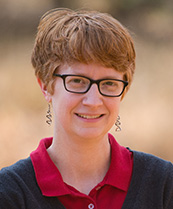 Erin Friedman
Erin Friedman
ASPB Education Committee Chair
Note: This interview was originally published in Judy Callis’ President’s Letter “The New Normal”
To help members get to know you, how did you get into plant science?
My dad, Steve Browder, has a PhD in plant physiology and taught biology at Franklin College, a small primarily undergraduate institution (PUI) in central Indiana. Some of my earliest childhood memories include running around campus, coloring on lecture handouts, and even attending ASPP meetings. I wouldn’t say it was inevitable that I ended up as a plant scientist teaching at a PUI, but I probably didn’t surprise anyone, either!
Although I’ve always loved biology, it was Jim Shinkle’s plant physiology course at Trinity University that really sealed the deal. A lab experiment in the course led to an independent research project investigating the effects of UVB radiation on cucumber seedling root growth, which ultimately led to me pursuing a PhD under the guidance of Alan Jones at the University of North Carolina at Chapel Hill. I was (and still am) fascinated by the range of stresses that plants can tolerate.
What do you value about your ASPB membership?
ASPB is the community that I didn’t know I needed. In graduate school, I was immersed in a local community of plant scientists, but when I moved to central Virginia to begin my PUI career at the University of Lynchburg, I was suddenly the only plant molecular biologist on campus. When I joined the Education Committee that same year, I quickly found a place in the larger ASPB community. The true beauty of ASPB is that our members represent a wonderfully diverse group of passionate and engaged individuals; their excitement about plant science is contagious, and I’ve been able to bring that back to my students.
Thank you for your service as chair of the Education Committee. As you begin your leadership, is there anything in particular you would like your committee to focus on? Any thoughts about the committee that you would like to share?
I am fortunate to work with a committee of motivated, dedicated, and creative individuals. Education and outreach is an incredibly broad umbrella, and our biggest challenge has been balancing our limited time, budget, and cognitive bandwidth with our lofty goal of eradicating plant blindness in K–16 students and the general public. One goal I have as chair is to identify gaps in our current catalog of educational offerings and then leverage ASPB programs like Plant BLOOME and Transforming Education in Plant Biology to generate new resources we can share with the community.
The COVID-19 pandemic has created a “new normal” in our lives. How has it affected your teaching?
I chose to teach at a PUI because forming relationships with my students is one of the most rewarding aspects of my teaching. I can tell when my students are confused, excited, overwhelmed, or bored just by walking into the room and seeing their faces. I can even sometimes get them to laugh (or at least roll their eyes) at my nerdy jokes.
I’m now teaching online, and I genuinely miss my students. I find it hard to determine when to launch into greater detail or just move on with difficult content. I don’t know how they’re feeling most of the time (and I know some are really struggling), and I miss our informal conversations in the hallways. Teaching from home also brings new challenges—my husband (a high school math teacher) and I now share a “classroom,” and we’ve added our 7- and 10-year-old boys to our rosters. We’re doing our best to continue on, but it certainly can be stressful.
ASPB members share a common goal of promoting the growth, development, and outreach of plant biology as a pure and applied science. This series features some of the dedicated and innovative members of ASPB who believe that membership in our Society is crucial to the future of plant biology. If you are interested in contributing to this feature, please contact ASPB Membership at info@aspb.org
